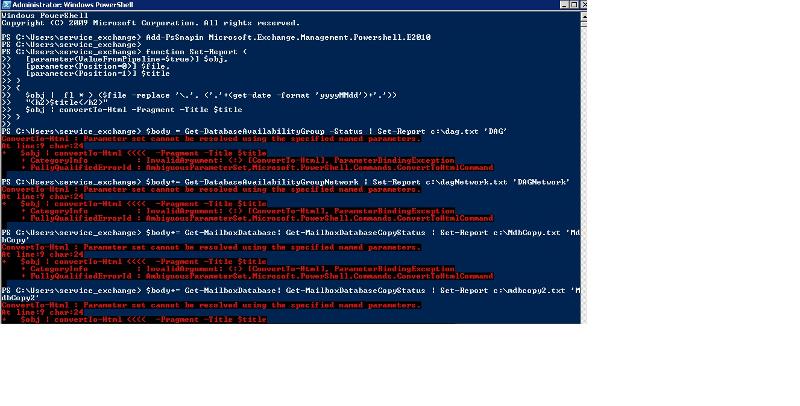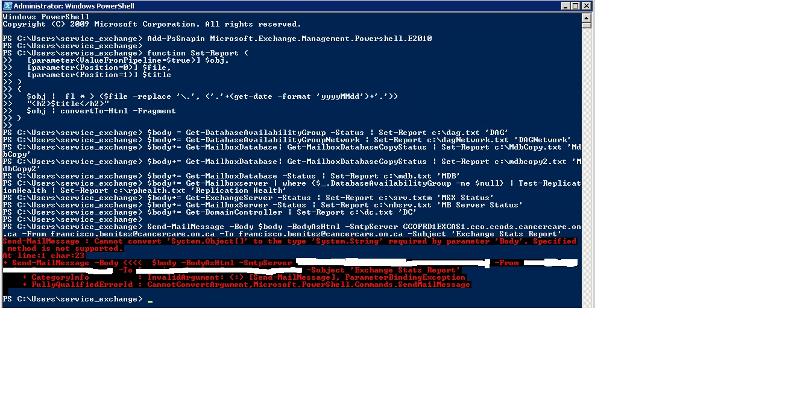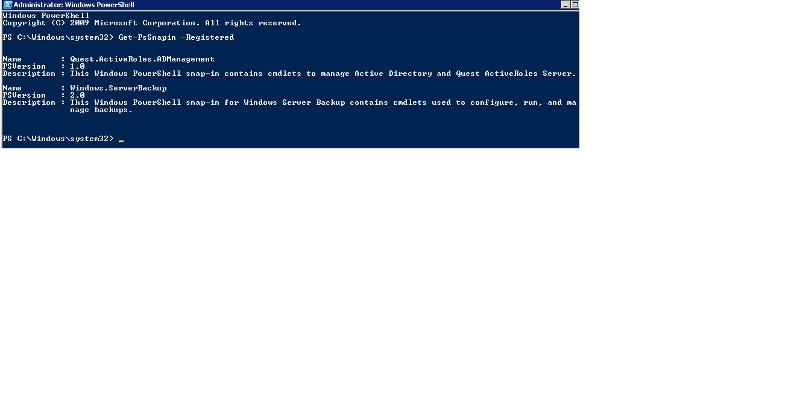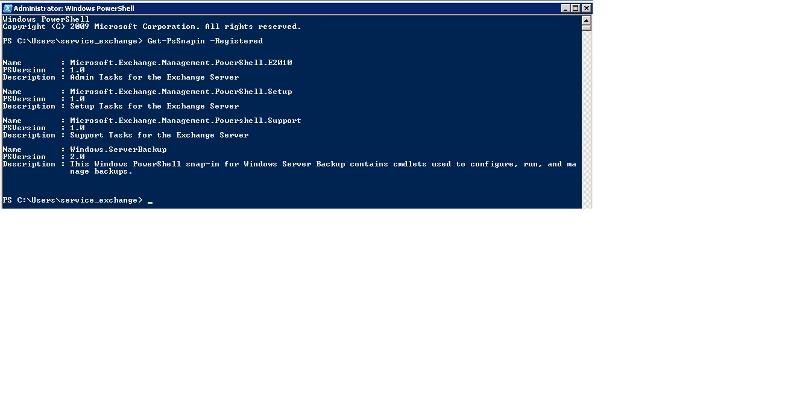Help to build a PowerShell Script
Hello Experts,
I would like to include all power shell cmdlets below into a single master script, and run from any server, therefore, I have to include the power shell AD and Exchange modules plus all the commands below. I would like to save all the results[txt files] to a shared folder, and displayed the information for each test on a HTML page, as well to send an email to a specific email mailbox
1. Get-DatabaseAvailabilityGr
2. Get-DatabaseAvailabilityGr
3. Get-MailboxDatabase| Get-MailboxDatabaseCopySta
4. Get-MailboxDatabase| Get-MailboxDatabaseCopySta
5. Get-MailboxDatabase -Status | fl >c:\mdb.txt
6. Get-Mailboxserver | where {$_.DatabaseAvailabilityGr
7. Get-ExchangeServer -Status | fl >c:\srv.txt
8. Get-MailboxServer -Status | fl >c:\mbsrv.txt
9. Get-DomainController >c:\dc.txt
Any ideas?
I would like to include all power shell cmdlets below into a single master script, and run from any server, therefore, I have to include the power shell AD and Exchange modules plus all the commands below. I would like to save all the results[txt files] to a shared folder, and displayed the information for each test on a HTML page, as well to send an email to a specific email mailbox
1. Get-DatabaseAvailabilityGr
2. Get-DatabaseAvailabilityGr
3. Get-MailboxDatabase| Get-MailboxDatabaseCopySta
4. Get-MailboxDatabase| Get-MailboxDatabaseCopySta
5. Get-MailboxDatabase -Status | fl >c:\mdb.txt
6. Get-Mailboxserver | where {$_.DatabaseAvailabilityGr
7. Get-ExchangeServer -Status | fl >c:\srv.txt
8. Get-MailboxServer -Status | fl >c:\mbsrv.txt
9. Get-DomainController >c:\dc.txt
Any ideas?
ASKER
Hi Dale,
What if we remove the HTML request from the equation and just build the script with the commands above, and save all results onto a shared folder, and in one line send an email to a mailbox with all results above?
if so, how would the script looks?
What if we remove the HTML request from the equation and just build the script with the commands above, and save all results onto a shared folder, and in one line send an email to a mailbox with all results above?
if so, how would the script looks?
Here's an example of your first command, just rinse and repeat for each:
$FilePath = "\\10.10.10.10\sharedfolde
$FileName = "LogFile.txt"
$Body = @()
$GDAG = Get-DatabaseAvailabilityGr
$GDAG >> "$FilePath\$FileName"
$Body += $GDAG
send-mailmessage -to "User01 <user01@example.com>" -from "User02 <user02@example.com>" -subject "Test mail" -body $Body -smtpserver "Exchange.contoso.com"
$FilePath = "\\10.10.10.10\sharedfolde
$FileName = "LogFile.txt"
$Body = @()
$GDAG = Get-DatabaseAvailabilityGr
$GDAG >> "$FilePath\$FileName"
$Body += $GDAG
send-mailmessage -to "User01 <user01@example.com>" -from "User02 <user02@example.com>" -subject "Test mail" -body $Body -smtpserver "Exchange.contoso.com"
ASKER
Should I repeat all code above for each PowerShell cmdlets? Basically what I need is
1. Run all powershell cmdlets above, save all results[each txt file] onto a shared folder
2. Send a single email with all the results[files above] to a specific email address
1. Run all powershell cmdlets above, save all results[each txt file] onto a shared folder
2. Send a single email with all the results[files above] to a specific email address
That depends on whether you want to have individual emails for each report. If not, I recommend to convert the output of each command to a HTML Table (fragment), concat those together, put some HTML code around and in between. The result can be used in a HTML page and as email.
Whatever you do, I recommend to write a function doing the work, so you can use something like:
Whatever you do, I recommend to write a function doing the work, so you can use something like:
Get-DatabaseAvailabilityGroup -Status | Set-Report '\\server\share\dag.txt'$body = Get-DatabaseAvailabilityGroup -Status | Set-Report '\\server\share\dag.txt'
$body+= Get-DatabaseAvailabilityGroupNetwork | Set-Report '\\server\share\dagNetwork.txt'
# ...
Send-MailMessage <# etc #>function Set-Report (
[parameter (ValueFormPipeline=$true)} $obj,
[parameter (Position=0)] $file
)
{
$obj | fl * > $file
$obj | convertToHtml -Fragment
}ASKER
Thanks Qlemo,
Can you please combine all code above, and send me the final script?
Can you please combine all code above, and send me the final script?
Ok. I'll use the "single HTML mail" approach. You can add more HTML formatting if needed, and change the titles to something more appealing.
function Set-Report (
[parameter (ValueFormPipeline=$true)} $obj,
[parameter (Position=0)] $file
[parameter (Position=1)] $title
)
{
$obj | fl * > $file
"<h2>$title</h2>"
$obj | convertToHtml -Fragment -Title $title
}
$body = Get-DatabaseAvailabilityGroup -Status | Set-Report c:\dag.txt 'DAG'
$body+= Get-DatabaseAvailabilityGroupNetwork | Set-Report c:\dagNetwork.txt 'DAGNetwork'
$body+= Get-MailboxDatabase| Get-MailboxDatabaseCopyStatus | Set-Report c:\MdbCopy.txt 'MdbCopy'
$body+= Get-MailboxDatabase| Get-MailboxDatabaseCopyStatus | Set-Report c:\mdbcopy2.txt 'MdbCopy2'
$body+= Get-MailboxDatabase -Status | Set-Report c:\mdb.txt 'MDB'
$body+= Get-Mailboxserver | where {$_.DatabaseAvailabilityGroup -ne $null} | Test-ReplicationHealth | Set-Report c:\rphealth.txt 'Replication Health'
$body+= Get-ExchangeServer -Status | Set-Report c:\srv.txtm 'MSX Status'
$body+= Get-MailboxServer -Status | Set-Report c:\mbsrv.txt 'MB Server Status'
$body+= Get-DomainController | Set-Report c:\dc.txt 'DC'
Send-MailMessage -Body $body -BodyAsHtml -SmtpServer mx.domain.com -From admin@domain.com -To admin@domain.com -Subject 'Exchange Stats Report'ASKER
you rock
Thanks
I have one more question, and please let me know if another ticket is requested as the original ticket is resolved.
I am thinking of creating an automatic task on my domain controller or create a runbook on the orchestrator server to call the script above, but if I want to avoid duplication of the files obtained above,
Any chance to get those files with a format yyyy/dd/mm.txt? where yyyy/dd/mm is the actual date when the script is executed
For example
Get-DatabaseAvailabilityGr
Please advice
Thanks
I have one more question, and please let me know if another ticket is requested as the original ticket is resolved.
I am thinking of creating an automatic task on my domain controller or create a runbook on the orchestrator server to call the script above, but if I want to avoid duplication of the files obtained above,
Any chance to get those files with a format yyyy/dd/mm.txt? where yyyy/dd/mm is the actual date when the script is executed
For example
Get-DatabaseAvailabilityGr
Please advice
The best, but more complex, approach is to add the date in Set-Report itself.
The simple one is to add it to the call of Set-Report, as in your example above.
I'll show the complex one.
The simple one is to add it to the call of Set-Report, as in your example above.
I'll show the complex one.
function Set-Report (
[parameter (ValueFormPipeline=$true)} $obj,
[parameter (Position=0)] $file
[parameter (Position=1)] $title
)
{
$file = (split-path -Paren
$obj | fl * > ($file -replace '\.', ('.'+(get-date -format 'yyyyMMdd')+'.'))
"<h2>$title</h2>"
$obj | convertToHtml -Fragment -Title $title
}
$body = Get-DatabaseAvailabilityGroup -Status | Set-Report c:\dag.txt 'DAG'
$body+= Get-DatabaseAvailabilityGroupNetwork | Set-Report c:\dagNetwork.txt 'DAGNetwork'
$body+= Get-MailboxDatabase| Get-MailboxDatabaseCopyStatus | Set-Report c:\MdbCopy.txt 'MdbCopy'
$body+= Get-MailboxDatabase| Get-MailboxDatabaseCopyStatus | Set-Report c:\mdbcopy2.txt 'MdbCopy2'
$body+= Get-MailboxDatabase -Status | Set-Report c:\mdb.txt 'MDB'
$body+= Get-Mailboxserver | where {$_.DatabaseAvailabilityGroup -ne $null} | Test-ReplicationHealth | Set-Report c:\rphealth.txt 'Replication Health'
$body+= Get-ExchangeServer -Status | Set-Report c:\srv.txtm 'MSX Status'
$body+= Get-MailboxServer -Status | Set-Report c:\mbsrv.txt 'MB Server Status'
$body+= Get-DomainController | Set-Report c:\dc.txt 'DC'
Send-MailMessage -Body $body -BodyAsHtml -SmtpServer mx.domain.com -From admin@domain.com -To admin@domain.com -Subject 'Exchange Stats Report'ASKER
Thanks QLemo
As this script will run in a member server
Should we import the modules for AD and Exchange? Can you please add the lines before the function?
As this script will run in a member server
Should we import the modules for AD and Exchange? Can you please add the lines before the function?
This should be all you need. Put it to the very top of the script.
add-pssnapin Microsoft.Exchange.Management.PowerShell.Admin
import-module ActiveDirectory
That script looks great, Qlemo. I just noticed a slight hiccup on your 2nd line:
[parameter (ValueFormPipeline=$true)}
I think Value*From*PipeLine will need to be used.
[parameter (ValueFormPipeline=$true)}
I think Value*From*PipeLine will need to be used.
That's absolutely correct. And there was a wrong line 7. So:
add-pssnapin Microsoft.Exchange.Management.PowerShell.Admin
import-module ActiveDirectory
function Set-Report (
[parameter (ValueFromPipeline=$true)} $obj,
[parameter (Position=0)] $file
[parameter (Position=1)] $title
)
{
$obj | fl * > ($file -replace '\.', ('.'+(get-date -format 'yyyyMMdd')+'.'))
"<h2>$title</h2>"
$obj | convertToHtml -Fragment -Title $title
}
$body = Get-DatabaseAvailabilityGroup -Status | Set-Report c:\dag.txt 'DAG'
$body+= Get-DatabaseAvailabilityGroupNetwork | Set-Report c:\dagNetwork.txt 'DAGNetwork'
$body+= Get-MailboxDatabase| Get-MailboxDatabaseCopyStatus | Set-Report c:\MdbCopy.txt 'MdbCopy'
$body+= Get-MailboxDatabase| Get-MailboxDatabaseCopyStatus | Set-Report c:\mdbcopy2.txt 'MdbCopy2'
$body+= Get-MailboxDatabase -Status | Set-Report c:\mdb.txt 'MDB'
$body+= Get-Mailboxserver | where {$_.DatabaseAvailabilityGroup -ne $null} | Test-ReplicationHealth | Set-Report c:\rphealth.txt 'Replication Health'
$body+= Get-ExchangeServer -Status | Set-Report c:\srv.txtm 'MSX Status'
$body+= Get-MailboxServer -Status | Set-Report c:\mbsrv.txt 'MB Server Status'
$body+= Get-DomainController | Set-Report c:\dc.txt 'DC'
Send-MailMessage -Body $body -BodyAsHtml -SmtpServer mx.domain.com -From admin@domain.com -To admin@domain.com -Subject 'Exchange Stats Report'ASKER
Thanks You Folks for the help
ASKER
Folks, I know that i just close this ticket, but I was unable to run the powershell script above either by running the script or manually from powershell console and /or Exchange management shell
Please see attached screen shoots
Any ideas?
I tried to run from a domain controller, from an exchange servers, still no luck
ErrorUnabletoSetReport.png
Please see attached screen shoots
Any ideas?
I tried to run from a domain controller, from an exchange servers, still no luck
ErrorUnabletoSetReport.png
Still some typos - but you should have seen the important error messages at the top.
add-pssnapin Microsoft.Exchange.Management.PowerShell.Admin
import-module ActiveDirectory
function Set-Report (
[parameter (ValueFromPipeline=$true)] $obj,
[parameter (Position=0)] $file,
[parameter (Position=1)] $title
)
{
$obj | fl * > ($file -replace '\.', ('.'+(get-date -format 'yyyyMMdd')+'.'))
"<h2>$title</h2>"
$obj | convertToHtml -Fragment -Title $title
}
$body = Get-DatabaseAvailabilityGroup -Status | Set-Report c:\dag.txt 'DAG'
$body+= Get-DatabaseAvailabilityGroupNetwork | Set-Report c:\dagNetwork.txt 'DAGNetwork'
$body+= Get-MailboxDatabase| Get-MailboxDatabaseCopyStatus | Set-Report c:\MdbCopy.txt 'MdbCopy'
$body+= Get-MailboxDatabase| Get-MailboxDatabaseCopyStatus | Set-Report c:\mdbcopy2.txt 'MdbCopy2'
$body+= Get-MailboxDatabase -Status | Set-Report c:\mdb.txt 'MDB'
$body+= Get-Mailboxserver | where {$_.DatabaseAvailabilityGroup -ne $null} | Test-ReplicationHealth | Set-Report c:\rphealth.txt 'Replication Health'
$body+= Get-ExchangeServer -Status | Set-Report c:\srv.txtm 'MSX Status'
$body+= Get-MailboxServer -Status | Set-Report c:\mbsrv.txt 'MB Server Status'
$body+= Get-DomainController | Set-Report c:\dc.txt 'DC'
Send-MailMessage -Body $body -BodyAsHtml -SmtpServer mx.domain.com -From admin@domain.com -To admin@domain.com -Subject 'Exchange Stats Report'ASKER
Hi Qlemo,
still no luck, please see errors from screen shoots
ErrorFromMSExchangeServer.jpg
ErrorFromPowershellinDomainContr.jpg
still no luck, please see errors from screen shoots
ErrorFromMSExchangeServer.jpg
ErrorFromPowershellinDomainContr.jpg
My keyboard seems to suck up keys. convertToHtml is missing a dash, and should sound convertTo-Html. And there should be no space after Parameter ...
I don't know what to do with the second screenshot - it tells the Exchange cmdlets were not found, though they are in the first one.
I don't know what to do with the second screenshot - it tells the Exchange cmdlets were not found, though they are in the first one.
add-pssnapin Microsoft.Exchange.Management.PowerShell.Admin
import-module ActiveDirectory
function Set-Report (
[parameter(ValueFromPipeline=$true)] $obj,
[parameter(Position=0)] $file,
[parameter(Position=1)] $title
)
{
$obj | fl * > ($file -replace '\.', ('.'+(get-date -format 'yyyyMMdd')+'.'))
"<h2>$title</h2>"
$obj | convertTo-Html -Fragment -Title $title
}
$body = Get-DatabaseAvailabilityGroup -Status | Set-Report c:\dag.txt 'DAG'
$body+= Get-DatabaseAvailabilityGroupNetwork | Set-Report c:\dagNetwork.txt 'DAGNetwork'
$body+= Get-MailboxDatabase| Get-MailboxDatabaseCopyStatus | Set-Report c:\MdbCopy.txt 'MdbCopy'
$body+= Get-MailboxDatabase| Get-MailboxDatabaseCopyStatus | Set-Report c:\mdbcopy2.txt 'MdbCopy2'
$body+= Get-MailboxDatabase -Status | Set-Report c:\mdb.txt 'MDB'
$body+= Get-Mailboxserver | where {$_.DatabaseAvailabilityGroup -ne $null} | Test-ReplicationHealth | Set-Report c:\rphealth.txt 'Replication Health'
$body+= Get-ExchangeServer -Status | Set-Report c:\srv.txtm 'MSX Status'
$body+= Get-MailboxServer -Status | Set-Report c:\mbsrv.txt 'MB Server Status'
$body+= Get-DomainController | Set-Report c:\dc.txt 'DC'
Send-MailMessage -Body $body -BodyAsHtml -SmtpServer mx.domain.com -From admin@domain.com -To admin@domain.com -Subject 'Exchange Stats Report'ASKER
still no luck, I ran manually the script from windows power shell console on both domain controller and exchange mailbox server with no luck, please see new attached files[error 4 and 5]
Even if I run the script from exchange management shell, got same errors
Just to clarify, our DCs are Wndows 2008 R2, same OS for exchange 2010 SP3 servers
Error4.jpg
Error5.jpg
Even if I run the script from exchange management shell, got same errors
Just to clarify, our DCs are Wndows 2008 R2, same OS for exchange 2010 SP3 servers
Error4.jpg
Error5.jpg
Firstly, you won't just copy & paste the content in a shell window. It is much better to store the code in a .ps1 file, and in PowerShell just call the script (by using the full path name to the script).
Pasting directly into PS console only makes sense if you do it line after line, and only if there is no error.
It is impossible that the Exchange Management Shell behaves exactly the same. The Exchange snap-in is loaded, the environment prepared for Exchange, including some convinience commands. The only issue which should come up is an error message stating the Exchange snap-in is already loaded.
You can always check for registered snap-ins with Get-PsSnapin -Registered. It should show the Exchange one.
Pasting directly into PS console only makes sense if you do it line after line, and only if there is no error.
It is impossible that the Exchange Management Shell behaves exactly the same. The Exchange snap-in is loaded, the environment prepared for Exchange, including some convinience commands. The only issue which should come up is an error message stating the Exchange snap-in is already loaded.
You can always check for registered snap-ins with Get-PsSnapin -Registered. It should show the Exchange one.
ASKER
Hi Qlemo
I did save the script and run as ps1, still no luck. same errors
Any ideas?
why most cmdlet are not recognized as cmdlet by the powershell console?
I did save the script and run as ps1, still no luck. same errors
Any ideas?
why most cmdlet are not recognized as cmdlet by the powershell console?
Please type Get-PsSnapin -Registered in a PS console, and see if you can spot Exchange. I don't get what happens here.
ASKER
ASKER
Any ideas?
You have the Quest ActiveRole (AD) Cmdlets on the DC only, and the Exchange ones only on Exchange server. As-is, you need to run the commands on the Exchange server, and replace my first two code lines with
Add-PsSnapin Microsoft.Exchange.Management.Powershell.E2010ASKER
Here are the results
All the txt files were created now, but the html page was not created. The email was sent fine, but see the format below and notice any of the items contain any values, please see also attached screen shoot with the errors displayed
values, please see also attached screen shoot with the errors displayed
DAG
DAGNetwork
MdbCopy
MdbCopy2
MDB
Replication Health
MSX Status
MB Server Status
DC
All the txt files were created now, but the html page was not created. The email was sent fine, but see the format below and notice any of the items contain any
 values, please see also attached screen shoot with the errors displayed
values, please see also attached screen shoot with the errors displayedDAG
DAGNetwork
MdbCopy
MdbCopy2
MDB
Replication Health
MSX Status
MB Server Status
DC
I don't understand what you try to say here:
The email was sent fine, but see the format below and notice any of the items contain any values, please see also attached screen shoot with the errors displayedThe HTML part indeed contains a typo, I forgot to remove the title option, which does not work with -fragment:
Add-PsSnapin Microsoft.Exchange.Management.Powershell.E2010
function Set-Report (
[parameter(ValueFromPipeline=$true)] $obj,
[parameter(Position=0)] $file,
[parameter(Position=1)] $title
)
{
$obj | fl * > ($file -replace '\.', ('.'+(get-date -format 'yyyyMMdd')+'.'))
"<h2>$title</h2>"
$obj | convertTo-Html -Fragment
}
$body = Get-DatabaseAvailabilityGroup -Status | Set-Report c:\dag.txt 'DAG'
$body+= Get-DatabaseAvailabilityGroupNetwork | Set-Report c:\dagNetwork.txt 'DAGNetwork'
$body+= Get-MailboxDatabase| Get-MailboxDatabaseCopyStatus | Set-Report c:\MdbCopy.txt 'MdbCopy'
$body+= Get-MailboxDatabase| Get-MailboxDatabaseCopyStatus | Set-Report c:\mdbcopy2.txt 'MdbCopy2'
$body+= Get-MailboxDatabase -Status | Set-Report c:\mdb.txt 'MDB'
$body+= Get-Mailboxserver | where {$_.DatabaseAvailabilityGroup -ne $null} | Test-ReplicationHealth | Set-Report c:\rphealth.txt 'Replication Health'
$body+= Get-ExchangeServer -Status | Set-Report c:\srv.txtm 'MSX Status'
$body+= Get-MailboxServer -Status | Set-Report c:\mbsrv.txt 'MB Server Status'
$body+= Get-DomainController | Set-Report c:\dc.txt 'DC'
Send-MailMessage -Body $body -BodyAsHtml -SmtpServer mx.domain.com -From admin@domain.com -To admin@domain.com -Subject 'Exchange Stats Report'ASKER
Thanks qlemo
The issue of cannot convert to html is gone, but a new issue resurfaces
please see attached screen shoot. The email also was not sent this time, and it used to work before i guess is because the new issue
Can you please also clarify what type of file is .txtm?
The script is generating a file name srv.20140131.txtm. see line code below
$body+= Get-ExchangeServer -Status | Set-Report c:\srv.txtm 'MSX Status'

The issue of cannot convert to html is gone, but a new issue resurfaces
please see attached screen shoot. The email also was not sent this time, and it used to work before i guess is because the new issue
Can you please also clarify what type of file is .txtm?
The script is generating a file name srv.20140131.txtm. see line code below
$body+= Get-ExchangeServer -Status | Set-Report c:\srv.txtm 'MSX Status'

Yes, that is a consequence of the convert to HTML working now :/. Stupid me, of course you need to join the multiple strings (one string per line) to a single string before sending as mail, that is a requirement of Send-MailMessage which I tend to forget each time. Last line should be
Send-MailMessage -Body ($body -join "`n") -BodyAsHtml -SmtpServer mx.domain.com -From admin@domain.com -To admin@domain.com -Subject 'Exchange Stats Report'ASKER
Hi Qlemo,
The Script worked like a rock, however the format of the html page displayed on the email is wrong. I have attached a MSG file with the information displayed on the email, you can open the file with Microsoft outlook and you will see
Any ideas on why the information is being displayed on that format?
Exchange-Stats-Report.msg
The Script worked like a rock, however the format of the html page displayed on the email is wrong. I have attached a MSG file with the information displayed on the email, you can open the file with Microsoft outlook and you will see
Any ideas on why the information is being displayed on that format?
Exchange-Stats-Report.msg
There are several issues. Too many properties to nicely show on a table, properties not expanding (so you don't see the content, but some type info), and such.
Creating a proper HTML report for each object is more complex than you should think. There is no direct way to do a format-list into HTML, sadly.
Creating a proper HTML report for each object is more complex than you should think. There is no direct way to do a format-list into HTML, sadly.
ASKER
Thanks Qlemo,
Is there an option to export all the txt objects into a CSV file, and use format-list? I mean, just wonder if we could export all reports [txt files] onto a single master csv report
Is there an option to export all the txt objects into a CSV file, and use format-list? I mean, just wonder if we could export all reports [txt files] onto a single master csv report
ASKER CERTIFIED SOLUTION
membership
This solution is only available to members.
To access this solution, you must be a member of Experts Exchange.
ASKER
Qlemo, the latest code basically is what i was looking for. Many thanks for your patience and help
ASKER
Excellent help


$OverallVariable = @()
$Variable = <command>
$OverallVariable+= $Variable
$HTML = "<HTML>`n `
<HEAD>`n `
<TITLE>Test Title</TITLE>`n `
</HEAD>`n `
<BODY>`n `
This is my first HTML Variable output<br>`n `
$DatabaseAvailabilityGroup
<p>`n `
This is my second variable output<br> `n `
$DatabaseAvailabilityGroup
</BODY>`n `
</HTML>"
$HTML > "OutputHTMLFile.htm"
Things to note: `n = new line which will make your HTML file easier to read when it's output into the htm file, but as you know, spacing doesn't matter for HTML. Also ` at the end of each line (backtick is the name of the symbol, next to the 1 key) signifies to Powershell that you're doing a continuation of the line, so essentially it's all one big line. This is done to allow you to easily edit your powershell script output so you're not having to deal with a huge long line of code.
Hope that gets you started in the right direction, but like I mentioned, if you can get one to do all of those things (googling each separate thing you want to do like send an email is very doable), you can get them all. It will turn into a pretty lengthy script. I made a script in the past where I was doing the exact same thing, and it would have 5 or 6 functions, all based on health and availability, and then I would use that to test different left and right limits of acceptable operation and have it tell me when it needed to be looked at. So I would get an email with "Green" or "Red" status of each service I was testing. Getting the output into emails is one thing, but testing the output for what signifies work to be done on your part as the administrator is the thing that Powershell could really help with. For example, if the backup wasn't done daily, our logs would be >24 hours old, I could test for that and it would send me an email saying to backup the mailstore since it wasn't done. Also, I would go through each server and get the hard drive space percentages. Based on that data, I wanted an email that rolled up the servers that had less than 30% space remaining, I didn't want to see which servers were above that level.
-Dale Harris